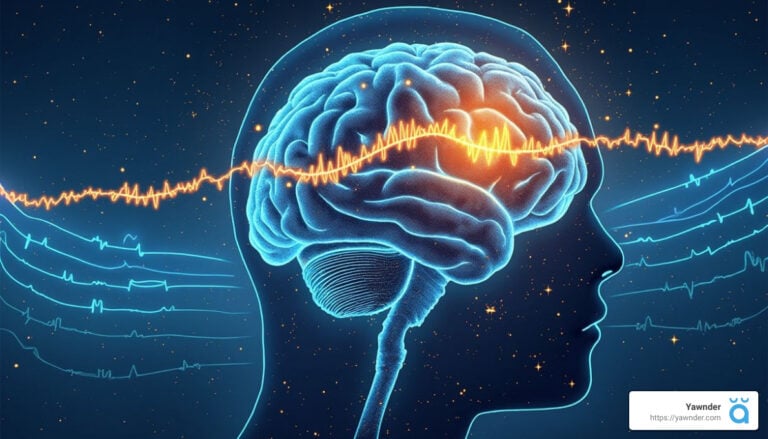The Definitive Guide to Understanding Alpha Sleep Waves
Introduction to Alpha Sleep Waves
Alpha sleep waves are an intriguing facet of brain activity that holds significant importance for relaxation and mental clarity. Understanding these waves can enhance your sleep experience and overall well-being. In this guide, we’ll explore what alpha sleep waves are, their benefits, and how you can harness them to improve your mental health and creativity.
What Are Alpha Sleep Waves?
Alpha waves are brain waves with a frequency range of 8 to 13 Hz. They typically manifest when we are awake yet in a relaxed state—think of moments spent meditating or unwinding just before sleep. During lighter stages of sleep and REM sleep, alpha waves play a vital role by promoting relaxation and mental calmness.
– Characteristics of Alpha Waves
– Frequency Range: 8-13 Hz
– Associated Mental State: Awakening but relaxed, light sleep, and REM sleep
– Presence: Common in the occipital lobe at the back of the brain, involved in visual processing
When these waves are active, our minds become calm but retain alertness, ideal for focused thinking and creativity. However, the intrusion of alpha waves into deeper sleep phases can lead to issues like insomnia and other sleep disorders affecting your overall health.
Alpha Waves vs. Other Brain Waves
To better appreciate the significance of alpha sleep waves, it’s helpful to differentiate them from other brain waves:
– Beta Waves (13-60 Hz): Fast waves associated with active thinking, problem-solving, and sometimes anxiety. They dominate when we are fully engaged in tasks.
– Theta Waves (4-7 Hz): Slower than alpha waves, often present during light sleep and deep relaxation, transitioning us from wakefulness to slumber.
– Delta Waves (0.5-4 Hz): The slowest brain waves, vital for deep, restorative sleep that supports physical and mental recovery.
– Gamma Waves (30-100 Hz): The fastest, involved in high-level information processing and cognitive functioning.
The Role of Alpha Waves in Sleep
Alpha waves typically surface during phases of light sleep or when we are awake but relaxed. Unfortunately, these waves can intrude into deeper sleep stages, leading to a phenomenon known as alpha-delta sleep. This disruption may manifest as hypervigilance—a persistent state of alertness that can deter restful sleep.
Alpha Intrusions and Sleep Disorders
Certain sleep disorders exhibit higher frequencies of alpha intrusions, notably:
– Insomnia: A common condition making it challenging to fall or stay asleep, worsened by disrupted deep sleep.
– Obstructive Sleep Apnea: A condition where breathing stops and starts during sleep, leading to fragmented rest and increased alpha activity.
– Circadian Rhythm Disorders: Irregular sleep cycles can trigger more alpha intrusions.
– Narcolepsy: A disorder characterized by excessive daytime sleepiness and unusual alpha wave patterns.
Measuring Alpha Waves
Using specialized techniques, medical professionals can assess alpha wave activity to diagnose related sleep disorders:
– Electroencephalography (EEG): A non-invasive method using electrodes on the scalp to capture brain wave patterns, crucial for analyzing sleep stages.
– Polysomnography: This comprehensive sleep study records brain waves, oxygen levels, heart rate, and breathing, providing a thorough profile of sleep architecture.
Monitoring alpha waves in sleep studies has revealed that their intrusions can significantly affect the restorative stages of sleep. Understanding these waves enables healthcare professionals to tailor treatments for improved sleep quality, fostering both physical and mental health.
Benefits of Alpha Waves
Enhancing Relaxation and Reducing Stress
Alpha waves serve as your brain’s natural chill pill. When these waves are active, they foster a state of relaxed alertness adept for unwinding after a demanding day. Research indicates that practices like meditation and deep breathing can amplify alpha wave activity, leading to reduced stress and heightened calmness.
Boosting Creativity
Ever experienced a Eureka! moment? This burst of inspiration may stem from the activation of your alpha waves, creating an ideal environment for creative thinking and problem-solving. Artists and scientists frequently find their most innovative ideas emerge during periods of relaxed alertness.
Supporting Mental Coordination and Stability
Alpha waves enhance your ability to juggle multiple tasks and process information effectively. When in this optimal state, you’re not just relaxed but also gain the ability to focus and operate efficiently. Furthermore, balanced alpha wave levels promote emotional stability, diminishing feelings of anxiety and depression.
How to Increase Alpha Waves
Increasing your alpha wave activity can yield numerous benefits. Here are effective strategies to do so:
1. Meditation
Regular meditation significantly enhances alpha wave activity. Taking just 10-20 minutes daily to focus on your breath or a calming mantra can prompt profound benefits.
2. Deep Breathing
Practicing deep breathing exercises activates your parasympathetic nervous system, raising alpha waves. Try the 4-7-8 technique: inhale for 4 seconds, hold for 7, and exhale for 8. Repeat this for several minutes.
3. Neurofeedback
This biofeedback technique trains your brain to increase alpha waves. Through real-time feedback, you can learn to control your brain activity, aiding in anxiety reduction and improved focus.
4. Physical Exercise
Engaging in aerobic activities, like jogging or cycling, stimulates alpha wave production. Aim for at least 30 minutes of moderate exercise most days.
5. Binaural Beats
Listening to binaural beats—two different sound frequencies in each ear—can boost alpha wave activity, improving relaxation and mental clarity.
6. Time in Nature
Nature offers a serene setting that can enhance alpha wave production. Spending 20-30 minutes outdoors can help you reconnect and recharge.
7. Visualization Techniques
Using visualization—imagining calming scenes can increase alpha waves. Immerse yourself in these mental images daily for 10-15 minutes.
Conclusion
Understanding and harnessing alpha sleep waves can profoundly enhance relaxation, creativity, and overall mental health. By incorporating effective practices like meditation, deep breathing, and spending time in nature, you can boost your alpha waves and enjoy these numerous benefits. Embrace the calming power of alpha sleep waves, and pave the way for improved wellness and creativity in your daily life. For more information on enhancing your sleep and mental health, explore our resources dedicated to sleep studies and wellness practices.

















